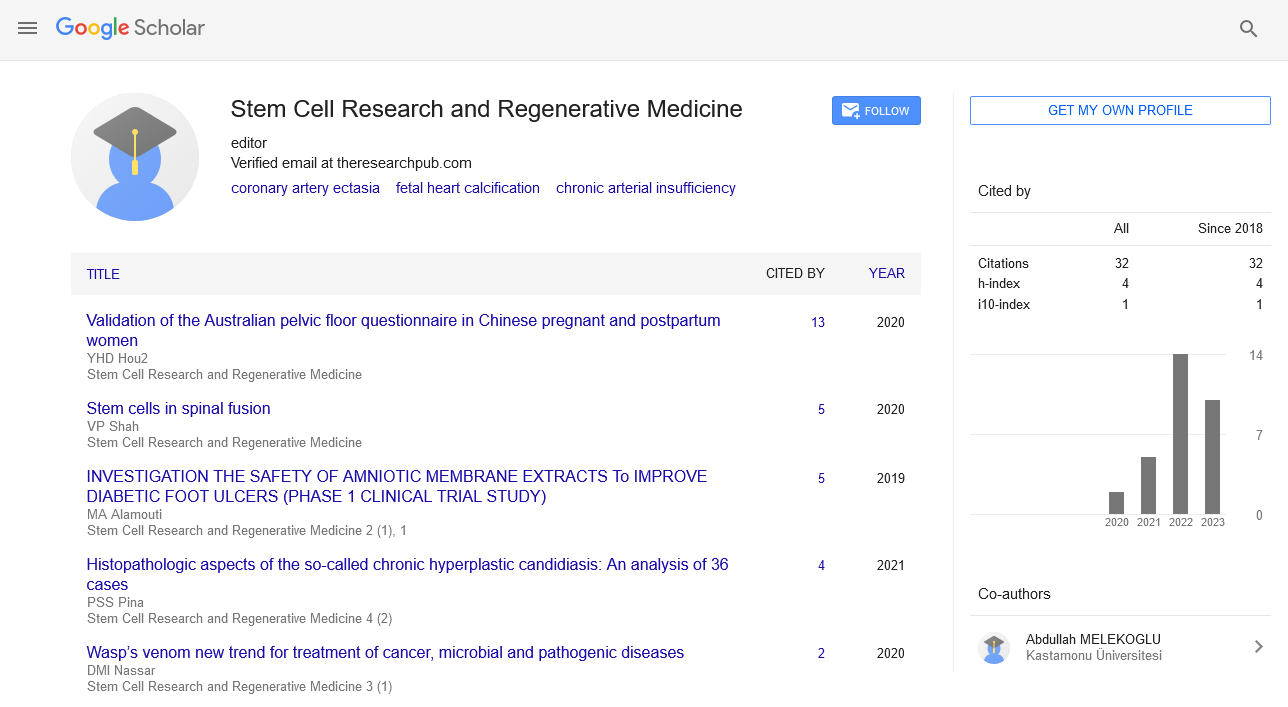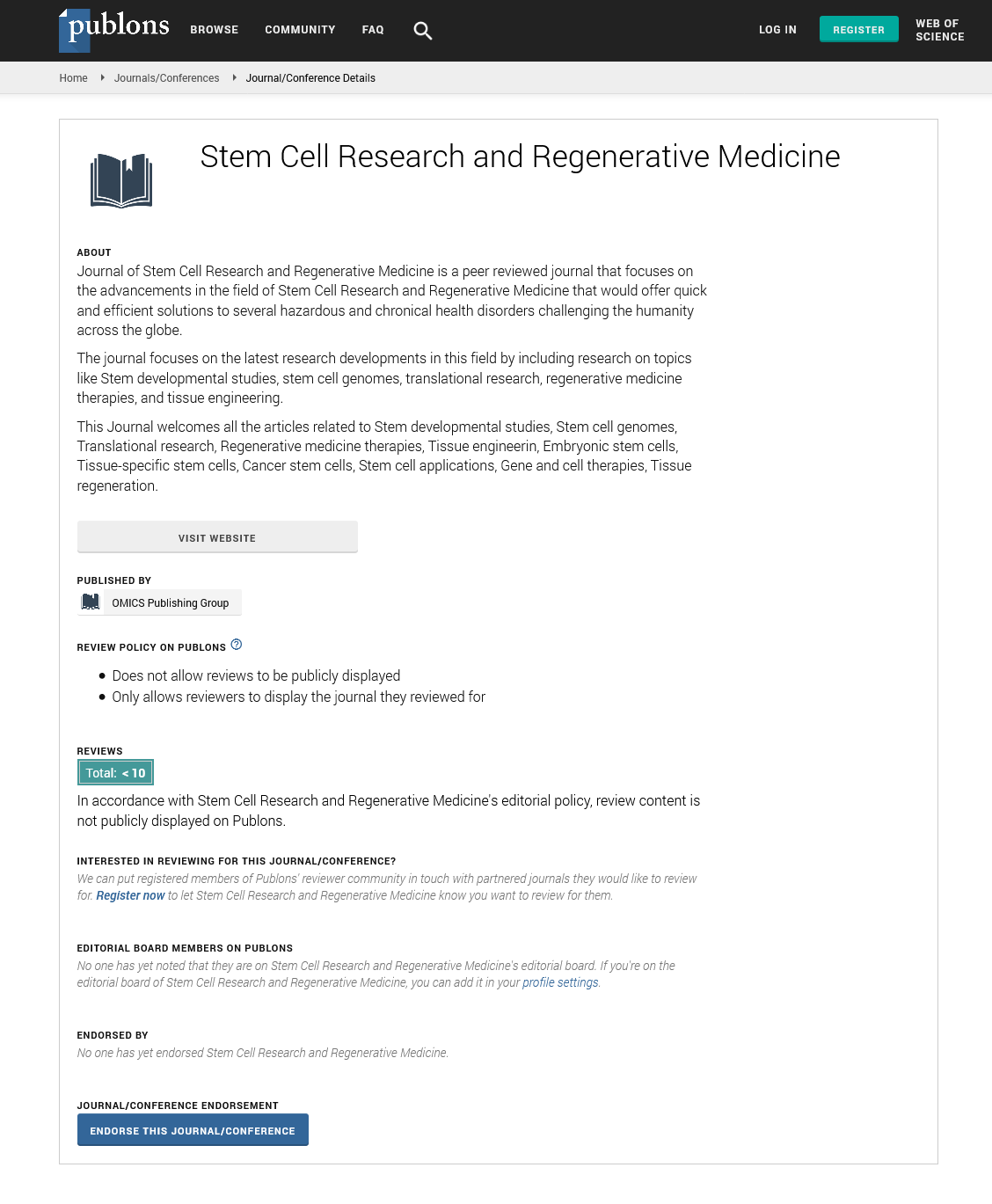Perspective - Stem Cell Research and Regenerative Medicine (2024) Volume 7, Issue 3
Computational Biology: Transforming Biomedical Research and Healthcare
- Corresponding Author:
- Lawrence W. Stanton
Department of Computational Biology,
University of Turku,
Turku,
Finland
E-mail: lawton@hbku.edu.qa
Received: 29-May-2024, Manuscript No. SRRM-24-137547; Editor assigned: 31-May-2024, Pre QC No. SRRM-24-137547 (PQ); Reviewed: 12-Jun-2024, QC No. SRRM-24-137547; Revised: 21-Jun-2024, Manuscript No. SRRM-24-137547 (R); Published: 28-Jun-2024, DOI: 10.37532/ SRRM.2024.7(3).212-214
Introduction
Computational biology, an interdisciplinary field that combines biology, computer science, mathematics, and statistics, has revolutionized the way we understand biological systems and develop medical treatments. This field leverages computational techniques to analyze and model complex biological data, providing insights that would be difficult or impossible to achieve through traditional experimental methods alone. The rapid growth of computational biology is driven by advances in high-throughput technologies, such as next-generation sequencing, and the increasing availability of large-scale biological data. This article explores the impact of computational biology on biomedical research and healthcare, discussing its applications, challenges, and future directions.
Description
One of the most significant contributions of computational biology is in the field of genomics. The sequencing of the human genome, completed in 2003, marked the beginning of a new era in biomedical research. Computational biology played a crucial role in assembling and analyzing the vast amounts of data generated by the Human Genome Project. Since then, the cost of sequencing has dropped dramatically, leading to an explosion of genomic data. Computational tools are essential for managing, analyzing, and interpreting this data, enabling researchers to identify genetic variations associated with diseases, understand gene function, and explore the genetic basis of human diversity.
In cancer research, computational biology has been instrumental in identifying driver mutations and understanding tumor heterogeneity. By analyzing genomic data from cancer patients, researchers can pinpoint mutations that contribute to tumor growth and progression. These insights have led to the development of targeted therapies that specifically inhibit the activity of mutated proteins, offering more effective and personalized treatment options for cancer patients. Additionally, computational approaches are used to study the clonal evolution of tumors, track the emergence of resistance to therapy, and design combination treatments to overcome resistance.
Another critical application of computational biology is in the field of transcriptomics, which involves the study of RNA transcripts produced by the genome. High-throughput RNA sequencing (RNA-seq) technologies generate vast amounts of transcriptomic data, requiring sophisticated computational methods for analysis. Computational tools can quantify gene expression levels, identify differentially expressed genes between conditions, and uncover alternative splicing events. These analyses provide insights into gene regulation, cellular responses to environmental stimuli, and the molecular mechanisms underlying diseases. For example, transcriptomic profiling of cancer cells has revealed distinct gene expression signatures associated with different cancer subtypes, aiding in diagnosis and treatment planning.
Proteomics, the study of the entire set of proteins produced by an organism, also benefits significantly from computational biology. Mass spectrometry-based proteomics generates large datasets of protein abundances, modifications, and interactions. Computational tools are used to identify and quantify proteins, predict protein structures, and map protein-protein interaction networks. These analyses are crucial for understanding cellular functions, signaling pathways, and the impact of genetic mutations on protein activity. In drug discovery, computational proteomics can identify potential drug targets and biomarkers for disease diagnosis and prognosis.
The field of systems biology, which aims to understand the behavior of biological systems as a whole, relies heavily on computational modeling and simulation. Biological systems are inherently complex, involving numerous interacting components that give rise to emergent properties. Computational models can integrate diverse types of biological data, such as genomic, transcriptomic, proteomic, and metabolomic data, to simulate the dynamics of cellular processes and predict system behavior under different conditions. These models are valuable for generating testable hypotheses, guiding experimental design, and interpreting experimental results. For instance, systems biology approaches have been used to model the immune response to infections, identify key regulatory genes in development, and understand the metabolic alterations in cancer cells.
In addition to its impact on basic research, computational biology is transforming healthcare by enabling precision medicine. Precision medicine aims to tailor medical treatments to individual patients based on their genetic, environmental, and lifestyle factors. Computational tools are essential for integrating and analyzing the diverse types of data required for precision medicine, including genomic, transcriptomic, proteomic, and clinical data. By identifying genetic variants associated with drug response, computational biology can guide the selection of the most effective therapies for individual patients, minimizing adverse effects and improving treatment outcomes. Moreover, computational approaches are used to develop predictive models of disease risk, enabling early detection and prevention strategies.
The integration of Artificial Intelligence (AI) and Machine Learning (ML) with computational biology is opening new avenues for research and healthcare. AI and ML algorithms can analyze complex and high-dimensional biological data, uncovering patterns and relationships that are difficult to detect with traditional methods. These approaches are being used to predict protein structures, identify potential drug candidates, and classify diseases based on molecular signatures. For example, deep learning algorithms have achieved remarkable success in predicting the 3D structures of proteins from their amino acid sequences, a long-standing challenge in structural biology. AI-driven drug discovery platforms can screen vast libraries of compounds, predict their biological activity, and optimize drug design, significantly accelerating the drug development process.
Despite the tremendous progress and potential of computational biology, several challenges remain. One major challenge is the integration of heterogeneous data from multiple sources. Biological data are generated using various technologies, each with its own limitations and biases. Integrating these data types requires sophisticated computational methods that can account for these differences and extract meaningful information. Additionally, the interpretation of large-scale biological data is often complicated by the presence of noise and variability, necessitating robust statistical and machine learning techniques.
Another challenge is the need for highperformance computing resources to handle the scale of biological data. The analysis of genomic, transcriptomic, and proteomic data requires significant computational power and storage capacity. Cloud computing and distributed computing frameworks are increasingly being used to meet these demands, providing scalable and cost-effective solutions for large-scale data analysis. However, the implementation of these technologies requires expertise in both computational biology and information technology, highlighting the need for interdisciplinary training and collaboration.
The ethical, legal, and social implications of computational biology also warrant careful consideration. The use of genomic data in research and healthcare raises privacy and security concerns, as genetic information is uniquely identifiable and can reveal sensitive information about individuals and their families. Ensuring the confidentiality and proper use of genomic data is essential to maintaining public trust and maximizing the benefits of computational biology. Additionally, the development and use of AI and ML algorithms in healthcare require transparency and accountability to avoid biases and ensure equitable access to medical treatments.
The future of computational biology holds exciting possibilities. Advances in single cell sequencing technologies are providing unprecedented insights into cellular heterogeneity and the behavior of individual cells within tissues. Computational tools are essential for analyzing single-cell data, enabling the identification of rare cell types, tracing cell lineages, and understanding cell-to-cell interactions. These insights are transforming our understanding of development, disease progression, and tissue regeneration.
Another promising direction is the integration of multi-omics data, which combines information from genomics, transcriptomics, proteomics, metabolomics, and other omics technologies. Multi-omics approaches provide a comprehensive view of biological systems, capturing the interplay between different molecular layers. Computational biology is crucial for integrating and analyzing multi-omics data, revealing new insights into the molecular mechanisms of diseases and identifying novel therapeutic targets. The application of computational biology in personalized medicine is expected to expand further with the advent of more sophisticated predictive models and decision support systems. These tools will enable clinicians to make more informed decisions based on a comprehensive analysis of individual patient data, improving the accuracy of diagnoses and the effectiveness of treatments. Moreover, the use of wearable devices and mobile health technologies is generating realtime health data, which can be integrated with other biological data to provide a holistic view of patient health and enable proactive healthcare management.
Conclusion
Computational biology is transforming the landscape of biomedical research and healthcare. By leveraging computational techniques to analyze and model complex biological data, this field is providing deep insights into the molecular mechanisms of diseases, guiding the development of targeted therapies, and enabling precision medicine. The integration of AI and machine learning with computational biology is further accelerating discoveries and innovations. Despite the challenges of data integration, computational demands, and ethical considerations, the future of computational biology holds immense promise. Continued advancements in this field will undoubtedly lead to new breakthroughs in our understanding of biology and the development of more effective and personalized medical treatments, ultimately improving patient outcomes and advancing healthcare.


